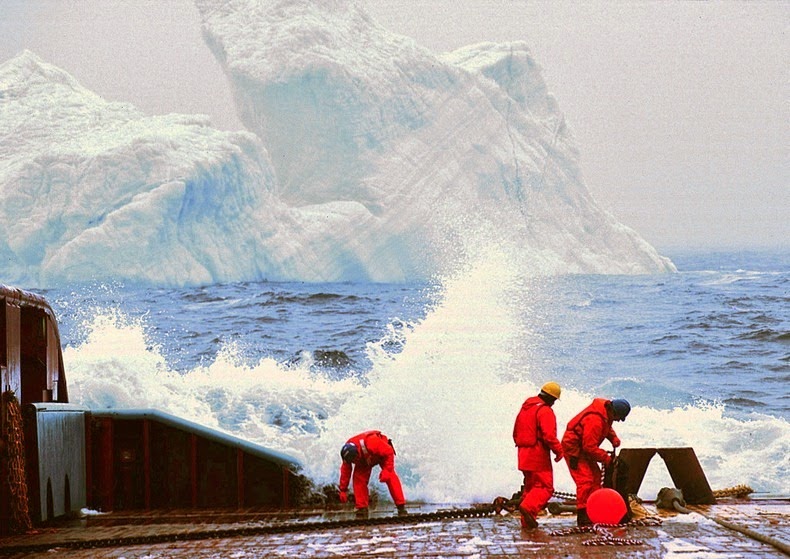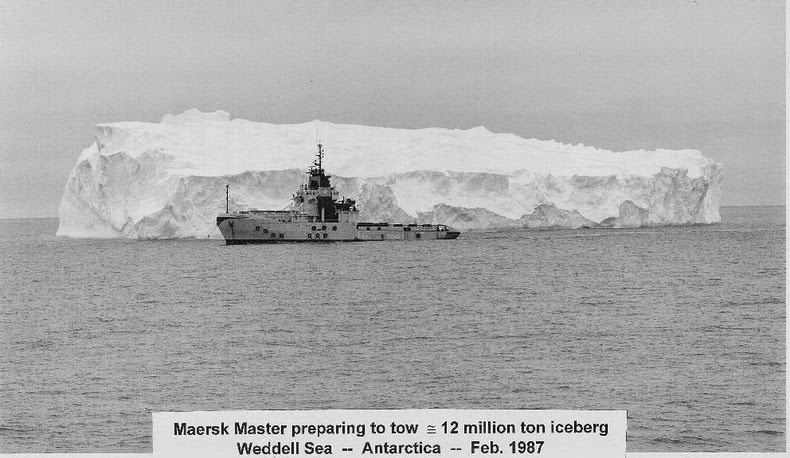Every year 20,000 to 40,000 icebergs are born out of glaciers in Greenland and carried away by the currents and into the North Atlantic where they threaten ships and oil installations off the coast of Newfoundland. An iceberg millions of tons in weight, don’t just bump into things – they slice through steel hulls and cause irreparable damage to offshore oil rigs. While a ship can alter course to avoid collision, an oil rig can only remain stationary watching in horror as a ten million-ton floating piece of ice approaches.
Instead, oil rigs hire independent ice management contractors whose job is to monitor movement of icebergs in the vicinity of the oil platform. When a particular iceberg is found to make a beeline for an offshore asset, its operators are alerted so that the rogue piece of ice can be towed out of harm’s way.

Photo: r3dmax
After the sinking of the RMS Titanic in 1912, after it hit a half-million-ton iceberg 400 miles south of Newfoundland, a consortium of North American and European nations established the International Ice Patrol (IIP) to prevent such tragedies. Using data from satellite and radar technology and airplane reconnaissance, IIP supplies information to the maritime community about potentially troublesome icebergs and lanes safe for travel. Ice management contractors use this data to identify those bergs that may be drifting into the danger area. When an iceberg is found to drift too close to a sea platform, anchor handling tug supply (AHTS) vessels are deployed to tow them away.
To round up an iceberg, the vessels uses polypropylene towropes eight inches in diameter, and up to 400 meters long a piece. The rope is attached to a buoy and the vessel goes around the iceberg staying within approximately 200 meters as the rope is played out. When the circling is complete the rope is attached to a tow cable three inch in diameter. Between 800 to 2,000 meters of open water is maintained between the vessel and the iceberg while it’s being towed. Icebergs can turn over when towed and some have hidden undersea projections that cause chaos when the bergs flip. And a flipping berg can generate large waves, which is why the vessels stay clear out of the iceberg during operation.
Because of the immense weight of the ice, towing can take up to three days and the vessel may need ten hours to reach a speed of just one knot. The icebergs aren’t towed all the way to safety; just pushed a sufficient distance so the current will carry it safely past the rig.
Towing vessels are also equipped with powerful water cannons to push away icebergs that can’t be towed. The Maersk Placentia tow boat has a water cannon that sprays 3,200 liters per hour through a five-inch nozzle at a force that can push the vessel back at three knots.
Iceberg towing is commonplace in the Arctic near oil rigs. Some ice management contractors has to regularly deal with 70 to 100 icebergs each year.

The MÆRSK TOPPER towing an iceberg out of the way of an offshore installation in the North Atlantic.

Workers prepare to “tow” an iceberg, lassoing it with enough force to move it out of the path of an oil platform. Reuters/STR New

Sources: Smithsonian / Graham Chandler / Ships and Doil



This is so cool.
ReplyDeleteAs an FYI... the "Ice Contractor" mentioned here I said PAL Aerospace of St. John's, NL.
ReplyDeleteWonder if Husky used a towing service when the SeaRose came with 1/4 mile of operations ? They talked about a disconnect but that sounds like a massive pain.
ReplyDelete